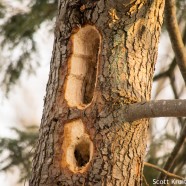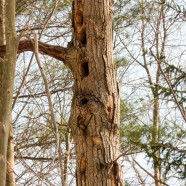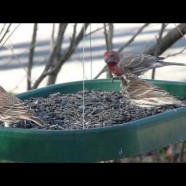Feeder Finches
There are three kinds of finches in these photos, and the views afford a great perspective of their relative sizes. The American Goldfinch, Pine Siskin and Purple Finch were all visitors to Twan’s yard recently. The Purple has such an enormous bill!
Read MorePileated Woodpecker Holes
These are some extra fresh Pileated Woodpecker holes! That wood looks like it has been cut very recently, and it certainly looks like a professional job. Whenever you see a dead or dying tree in your yard please try to leave it there if possible – if it is not infected with something such as Hemlock Woolly Adelgid, or a particularly dangerous falling hazard to people. It will end up serving a host of species that depend on these decaying plants for food, shelter and nesting. Cutting even these trees down solely for aesthetic purposes is robbing the environment of a vital component....
Read MorePileated Woodpecker Signs
Here is another telltale bird sign that you can find rather easily in the winter. Any guesses as to what species made these massive marks on this tree? The Pileated Woodpecker is a large, crow-size bird and as such it creates astonishingly huge holes with its big bill. Even though they are conspicuous birds when seen they can be tough to find in the first place because they have such large territories. If you cannot see them flashing by through mature woodlands try listening for their laughing call or finding these reminders of their presence.
Read MoreFerruginous Pygmy-Owl (Glaucidium ridgwayi)
This Ferruginous Pygmy-Owl (Glaucidium ridgwayi) was described by RTPI Affiliate Sean Graesser as “tiny in stature, but not in tenacity”. It is only the size of a large sparrow but he can personally attest to the amount of significant amount of damage the bill and talons can inflict upon prey or banding human handlers.
Read MorePurple Finch vs House Finch comparison with feeder birds
Here we have a female Purple Finch (Haemorhous purpureus) feeding throughout the video along with a female House Finch (Haemorhous mexicanus) and a male House Finch later on. A Tufted Titmouse (Baeolophus bicolor) and Black-capped Chickadee (Poecile atricapillus) also make an appearance among the common feeder birds visiting this tray of sunflower seeds. Note that the female Purple Finch is larger and bulkier than her House Finch counterpart. She has more boldly defined colors in all regards with additional heavier and stronger facial and head markings. Take a few watches to get a feel for...
Read More








